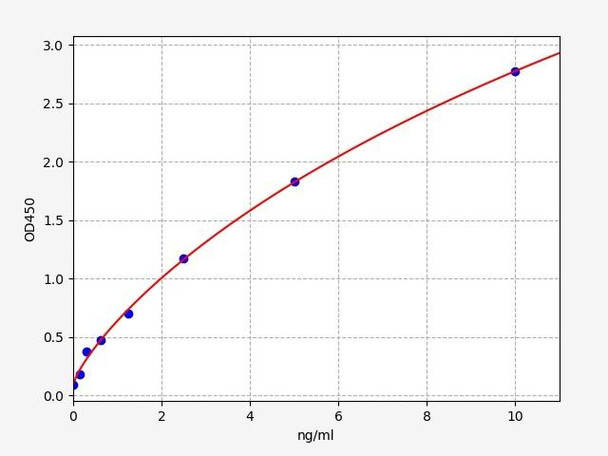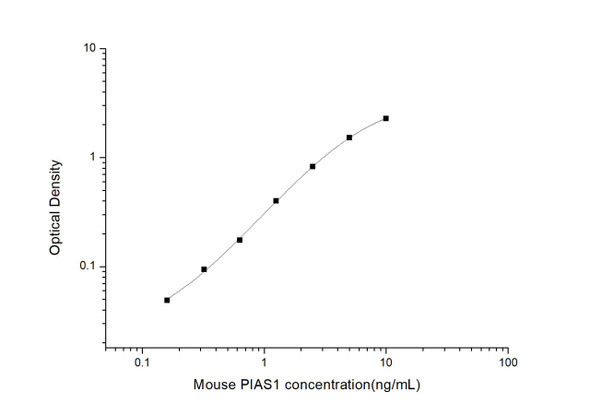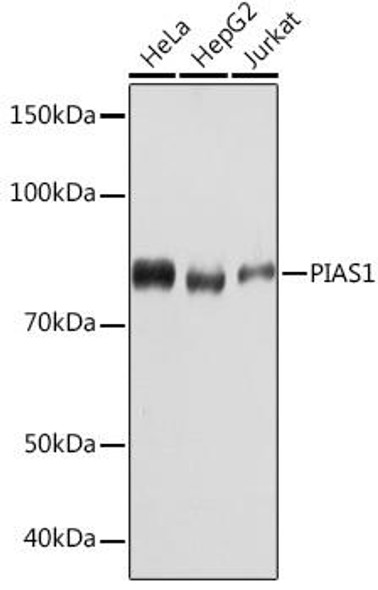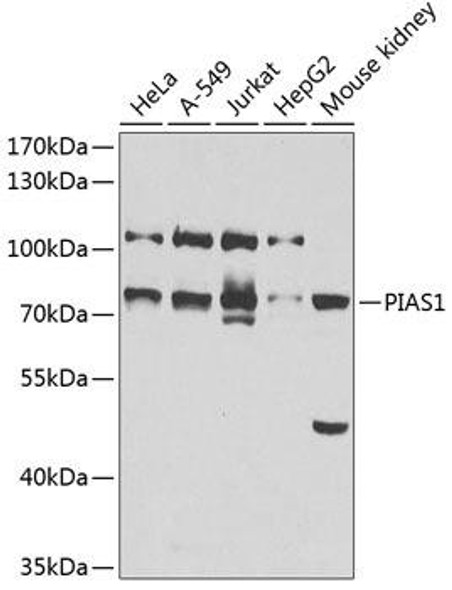Mouse PIAS1 ELISA Kit (MOFI01048)
- SKU:
- MOFI01048
- Product Type:
- ELISA Kit
- Size:
- 96 Assays
- Uniprot:
- O88907
- Sensitivity:
- 0.094ng/ml
- Range:
- 0.156-10ng/ml
- ELISA Type:
- Sandwich
- Synonyms:
- PIAS1, E3 SUMO-protein ligase PIAS1, DEAD, H box-binding protein 1, Protein inhibitor of activated STAT protein 1
- Reactivity:
- Mouse
- Research Area:
- Epigenetics and Nuclear Signaling
Description
Mouse PIAS1 ELISA Kit
The Mouse PIAS1 ELISA Kit is a highly sensitive and specific assay designed to accurately measure levels of PIAS1 (Protein Inhibitor of Activated STAT 1) in mouse serum, plasma, and cell culture supernatants. This kit provides researchers with reliable and reproducible results, making it ideal for a variety of research applications.PIAS1 is a critical protein involved in regulating gene expression and cell signaling pathways, particularly in the context of immune responses and inflammation.
Dysregulation of PIAS1 has been implicated in various diseases, including autoimmune disorders and cancer, making it a valuable biomarker for understanding disease pathogenesis and potential therapeutic interventions.With its high performance and versatility, the Mouse PIAS1 ELISA Kit is a valuable tool for scientists looking to study the role of PIAS1 in different disease models and explore its potential as a target for therapeutic intervention.
| Product Name: | Mouse PIAS1 ELISA Kit |
| Product Code: | MOFI01048 |
| Size: | 96 Assays |
| Alias: | PIAS1, E3 SUMO-protein ligase PIAS1, DEAD, H box-binding protein 1, Protein inhibitor of activated STAT protein 1 |
| Detection Method: | Sandwich ELISA |
| Application: | This immunoassay kit allows for the in vitro quantitative determination of Mouse PIAS1AS1AS1 concentrations in serum plasma and other biological fluids. |
| Sensitivity: | 0.094ng/ml |
| Range: | 0.156-10ng/ml |
| Storage: | 4°C for 6 months |
| Note: | For Research Use Only |
| Recovery: | Matrices listed below were spiked with certain level of Mouse PIAS1AS1AS1 and the recovery rates were calculated by comparing the measured value to the expected amount of Mouse PIAS1AS1AS1 in samples. | ||||||||||||||||
| |||||||||||||||||
| Linearity: | The linearity of the kit was assayed by testing samples spiked with appropriate concentration of Mouse PIAS1AS1AS1 and their serial dilutions. The results were demonstrated by the percentage of calculated concentration to the expected. | ||||||||||||||||
| |||||||||||||||||
| Intra Assay: | CV <8% | ||||||||||||||||
| Inter Assay: | CV <10% |
| Component | Quantity | Storage |
| ELISA Microplate (Dismountable) | 8×12 strips | 4°C for 6 months |
| Lyophilized Standard | 2 | 4°C/-20°C |
| Sample/Standard Dilution Buffer | 20ml | 4°C |
| Biotin-labeled Antibody(Concentrated) | 120ul | 4°C (Protect from light) |
| Antibody Dilution Buffer | 10ml | 4°C |
| HRP-Streptavidin Conjugate(SABC) | 120ul | 4°C (Protect from light) |
| SABC Dilution Buffer | 10ml | 4°C |
| TMB Substrate | 10ml | 4°C (Protect from light) |
| Stop Solution | 10ml | 4°C |
| Wash Buffer(25X) | 30ml | 4°C |
| Plate Sealer | 5 | - |
Other materials and equipment required:
- Microplate reader with 450 nm wavelength filter
- Multichannel Pipette, Pipette, microcentrifuge tubes and disposable pipette tips
- Incubator
- Deionized or distilled water
- Absorbent paper
- Buffer resevoir
| Uniprot | O88907 |
| UniProt Protein Function: | PIAS1: Functions as an E3-type small ubiquitin-like modifier (SUMO) ligase, stabilizing the interaction between UBE2I and the substrate, and as a SUMO-tethering factor. Plays a crucial role as a transcriptional coregulation in various cellular pathways, including the STAT pathway, the p53 pathway and the steroid hormone signaling pathway. In vitro, binds A/T-rich DNA. The effects of this transcriptional coregulation, transactivation or silencing, may vary depending upon the biological context. Together with PRMT1, may repress STAT1 transcriptional activity, in the late phase of interferon gamma (IFN-gamma) signaling. Interacts with NCOA2 and AR. Interacts with NR2C1; the interaction promotes its sumoylation. Interacts with DDX21, CSRP2, AXIN1, JUN, UBE2I, SUMO1, SATB2, PLAG1, TP53 and STAT1 (dimer), following IFNA1-stimulation. Interacts with SP3 (preferentially when SUMO-modified). Interacts with KLF8; the interaction results in SUMO ligation and repression of KLF8 transcriptional activity and of its cell cycle progression into G(1) phase. Interacts with STAT1. Interacts with CHUK/IKKA; this interaction induces PIAS1 phosphorylation. Interacts with PTK2/FAK1; the interaction promotes its sumoylation. Interacts with DDX5. Expressed in numerous tissues with highest level in testis. Belongs to the PIAS family. |
| UniProt Protein Details: | Protein type:SUMO conjugating system; Transcription, coactivator/corepressor; Nuclear receptor co-regulator; EC 6.3.2.- Cellular Component: PML body; intracellular; nucleus Molecular Function:protein C-terminus binding; protein domain specific binding; protein binding; enzyme binding; DNA binding; zinc ion binding; coenzyme F420-2 alpha-glutamyl ligase activity; ubiquitin protein ligase binding; UDP-N-acetylmuramoylalanyl-D-glutamyl-2,6-diaminopimelate-D-alanyl-D-alanine ligase activity; metal ion binding; ribosomal S6-glutamic acid ligase activity; coenzyme F420-0 gamma-glutamyl ligase activity; SUMO ligase activity; transcription corepressor activity; ligase activity Biological Process: transcription, DNA-dependent; positive regulation of smooth muscle cell differentiation; positive regulation of transcription, DNA-dependent; negative regulation of transcription from RNA polymerase II promoter; JAK-STAT cascade; protein-DNA complex assembly; regulation of cell proliferation; positive regulation of protein sumoylation; protein sumoylation; regulation of transcription, DNA-dependent; positive regulation of proteasomal ubiquitin-dependent protein catabolic process; negative regulation of apoptosis; G1/S transition of mitotic cell cycle |
| UniProt Code: | O88907 |
| NCBI GenInfo Identifier: | 31543478 |
| NCBI Gene ID: | 56469 |
| NCBI Accession: | NP_062637.2 |
| UniProt Secondary Accession: | O88907,Q8C6H5, |
| UniProt Related Accession: | O88907 |
| Molecular Weight: | 71,618 Da |
| NCBI Full Name: | E3 SUMO-protein ligase PIAS1 |
| NCBI Synonym Full Names: | protein inhibitor of activated STAT 1 |
| NCBI Official Symbol: | Pias1 |
| NCBI Official Synonym Symbols: | GBP; Ddxbp1; 2900068C24Rik |
| NCBI Protein Information: | E3 SUMO-protein ligase PIAS1 |
| UniProt Protein Name: | E3 SUMO-protein ligase PIAS1 |
| UniProt Synonym Protein Names: | DEAD/H box-binding protein 1; Protein inhibitor of activated STAT protein 1 |
| Protein Family: | E3 SUMO-protein ligase |
| UniProt Gene Name: | Pias1 |
| UniProt Entry Name: | PIAS1_MOUSE |
*Note: Protocols are specific to each batch/lot. For the correct instructions please follow the protocol included in your kit.
| Step | Procedure |
| 1. | Set standard, test sample and control (zero) wells on the pre-coated plate respectively, and then, record their positions. It is recommended to measure each standard and sample in duplicate. Wash plate 2 times before adding standard, sample and control (zero) wells! |
| 2. | Aliquot 0.1ml standard solutions into the standard wells. |
| 3. | Add 0.1 ml of Sample / Standard dilution buffer into the control (zero) well. |
| 4. | Add 0.1 ml of properly diluted sample (Human serum, plasma, tissue homogenates and other biological fluids.) into test sample wells. |
| 5. | Seal the plate with a cover and incubate at 37 °C for 90 min. |
| 6. | Remove the cover and discard the plate content, clap the plate on the absorbent filter papers or other absorbent material. Do NOT let the wells completely dry at any time. Wash plate X2. |
| 7. | Add 0.1 ml of Biotin- detection antibody working solution into the above wells (standard, test sample & zero wells). Add the solution at the bottom of each well without touching the side wall. |
| 8. | Seal the plate with a cover and incubate at 37°C for 60 min. |
| 9. | Remove the cover, and wash plate 3 times with Wash buffer. Let wash buffer rest in wells for 1 min between each wash. |
| 10. | Add 0.1 ml of SABC working solution into each well, cover the plate and incubate at 37°C for 30 min. |
| 11. | Remove the cover and wash plate 5 times with Wash buffer, and each time let the wash buffer stay in the wells for 1-2 min. |
| 12. | Add 90 µL of TMB substrate into each well, cover the plate and incubate at 37°C in dark within 10-20 min. (Note: This incubation time is for reference use only, the optimal time should be determined by end user.) And the shades of blue can be seen in the first 3-4 wells (with most concentrated standard solutions), the other wells show no obvious color. |
| 13. | Add 50 µL of Stop solution into each well and mix thoroughly. The color changes into yellow immediately. |
| 14. | Read the O.D. absorbance at 450 nm in a microplate reader immediately after adding the stop solution. |
When carrying out an ELISA assay it is important to prepare your samples in order to achieve the best possible results. Below we have a list of procedures for the preparation of samples for different sample types.
| Sample Type | Protocol |
| Serum: | If using serum separator tubes, allow samples to clot for 30 minutes at room temperature. Centrifuge for 10 minutes at 1,000x g. Collect the serum fraction and assay promptly or aliquot and store the samples at -80°C. Avoid multiple freeze-thaw cycles. If serum separator tubes are not being used, allow samples to clot overnight at 2-8°C. Centrifuge for 10 minutes at 1,000x g. Remove serum and assay promptly or aliquot and store the samples at -80°C. Avoid multiple freeze-thaw cycles. |
| Plasma: | Collect plasma using EDTA or heparin as an anticoagulant. Centrifuge samples at 4°C for 15 mins at 1000 × g within 30 mins of collection. Collect the plasma fraction and assay promptly or aliquot and store the samples at -80°C. Avoid multiple freeze-thaw cycles. Note: Over haemolysed samples are not suitable for use with this kit. |
| Urine & Cerebrospinal Fluid: | Collect the urine (mid-stream) in a sterile container, centrifuge for 20 mins at 2000-3000 rpm. Remove supernatant and assay immediately. If any precipitation is detected, repeat the centrifugation step. A similar protocol can be used for cerebrospinal fluid. |
| Cell culture supernatant: | Collect the cell culture media by pipette, followed by centrifugation at 4°C for 20 mins at 1500 rpm. Collect the clear supernatant and assay immediately. |
| Cell lysates: | Solubilize cells in lysis buffer and allow to sit on ice for 30 minutes. Centrifuge tubes at 14,000 x g for 5 minutes to remove insoluble material. Aliquot the supernatant into a new tube and discard the remaining whole cell extract. Quantify total protein concentration using a total protein assay. Assay immediately or aliquot and store at ≤ -20°C. |
| Tissue homogenates: | The preparation of tissue homogenates will vary depending upon tissue type. Rinse tissue with 1X PBS to remove excess blood & homogenize in 20ml of 1X PBS (including protease inhibitors) and store overnight at ≤ -20°C. Two freeze-thaw cycles are required to break the cell membranes. To further disrupt the cell membranes you can sonicate the samples. Centrifuge homogenates for 5 mins at 5000xg. Remove the supernatant and assay immediately or aliquot and store at -20°C or -80°C. |
| Tissue lysates: | Rinse tissue with PBS, cut into 1-2 mm pieces, and homogenize with a tissue homogenizer in PBS. Add an equal volume of RIPA buffer containing protease inhibitors and lyse tissues at room temperature for 30 minutes with gentle agitation. Centrifuge to remove debris. Quantify total protein concentration using a total protein assay. Assay immediately or aliquot and store at ≤ -20 °C. |
| Breast Milk: | Collect milk samples and centrifuge at 10,000 x g for 60 min at 4°C. Aliquot the supernatant and assay. For long term use, store samples at -80°C. Minimize freeze/thaw cycles. |







